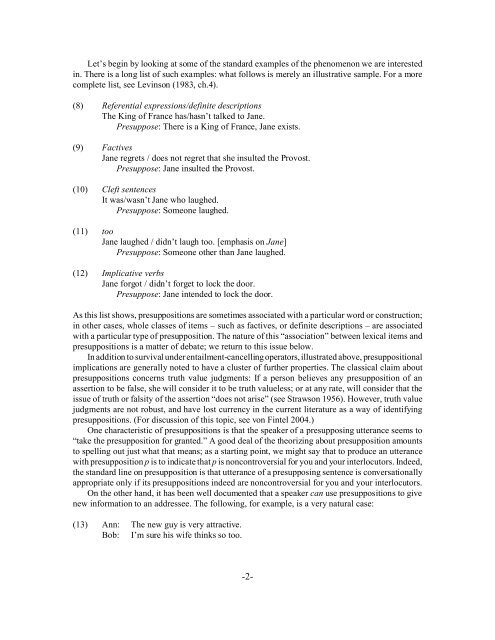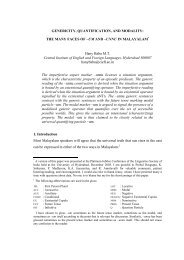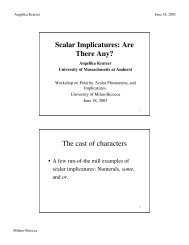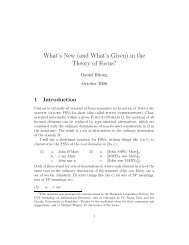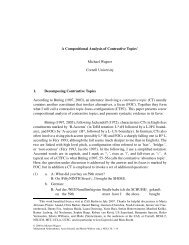Foundational Issues in Presupposition - New York University
Foundational Issues in Presupposition - New York University
Foundational Issues in Presupposition - New York University
Create successful ePaper yourself
Turn your PDF publications into a flip-book with our unique Google optimized e-Paper software.
Let’s beg<strong>in</strong> by look<strong>in</strong>g at some of the standard examples of the phenomenon we are <strong>in</strong>terested<br />
<strong>in</strong>. There is a long list of such examples: what follows is merely an illustrative sample. For a more<br />
complete list, see Lev<strong>in</strong>son (1983, ch.4).<br />
(8) Referential expressions/def<strong>in</strong>ite descriptions<br />
The K<strong>in</strong>g of France has/hasn’t talked to Jane.<br />
Presuppose: There is a K<strong>in</strong>g of France, Jane exists.<br />
(9) Factives<br />
Jane regrets / does not regret that she <strong>in</strong>sulted the Provost.<br />
Presuppose: Jane <strong>in</strong>sulted the Provost.<br />
(10) Cleft sentences<br />
It was/wasn’t Jane who laughed.<br />
Presuppose: Someone laughed.<br />
(11) too<br />
Jane laughed / didn’t laugh too. [emphasis on Jane]<br />
Presuppose: Someone other than Jane laughed.<br />
(12) Implicative verbs<br />
Jane forgot / didn’t forget to lock the door.<br />
Presuppose: Jane <strong>in</strong>tended to lock the door.<br />
As this list shows, presuppositions are sometimes associated with a particular word or construction;<br />
<strong>in</strong> other cases, whole classes of items – such as factives, or def<strong>in</strong>ite descriptions – are associated<br />
with a particular type of presupposition. The nature of this “association” between lexical items and<br />
presuppositions is a matter of debate; we return to this issue below.<br />
In addition to survival under entailment-cancell<strong>in</strong>g operators, illustrated above, presuppositional<br />
implications are generally noted to have a cluster of further properties. The classical claim about<br />
presuppositions concerns truth value judgments: If a person believes any presupposition of an<br />
assertion to be false, she will consider it to be truth valueless; or at any rate, will consider that the<br />
issue of truth or falsity of the assertion “does not arise” (see Strawson 1956). However, truth value<br />
judgments are not robust, and have lost currency <strong>in</strong> the current literature as a way of identify<strong>in</strong>g<br />
presuppositions. (For discussion of this topic, see von F<strong>in</strong>tel 2004.)<br />
One characteristic of presuppositions is that the speaker of a presuppos<strong>in</strong>g utterance seems to<br />
“take the presupposition for granted.” A good deal of the theoriz<strong>in</strong>g about presupposition amounts<br />
to spell<strong>in</strong>g out just what that means; as a start<strong>in</strong>g po<strong>in</strong>t, we might say that to produce an utterance<br />
with presupposition p is to <strong>in</strong>dicate that p is noncontroversial for you and your <strong>in</strong>terlocutors. Indeed,<br />
the standard l<strong>in</strong>e on presupposition is that utterance of a presuppos<strong>in</strong>g sentence is conversationally<br />
appropriate only if its presuppositions <strong>in</strong>deed are noncontroversial for you and your <strong>in</strong>terlocutors.<br />
On the other hand, it has been well documented that a speaker can use presuppositions to give<br />
new <strong>in</strong>formation to an addressee. The follow<strong>in</strong>g, for example, is a very natural case:<br />
(13) Ann: The new guy is very attractive.<br />
Bob: I’m sure his wife th<strong>in</strong>ks so too.<br />
-2-


